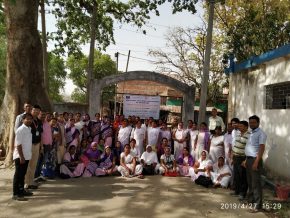SaciWATERs conducted a training program for the block level medical and paramedical practitioners on Prevention, Detection and Management of Arsenicosis in both Buxar and Bhagalpur districts, Bihar, India. The training lasted for 2 days in Bhagalpur (22-23 April 2019) and for the same duration in Buxar (27-28 April, 2019).
It was a response to the major gap identified through a baseline survey conducted by SaciWATERs: the lack of awareness among the rural communities regarding arsenic in drinking water and its health impacts. The survey was part of the project “Civil society voices, vulnerable communities and localised platform for addressing water quality challenges” supported by European Union.
The training included both classroom sessions as well as field exposure, with the main objectives being:
– To build capacities of the medical practitioner and community frontline workers on prevention, detection and management of arsenicosis, and estimate the health burden due to arsenic exposure.
– To identify manifestations due to arsenic exposure among the community.
– Understand community perception on safe water and health, and learn about simple individual level and community led solutions including alternate source for safe water.
It is of general knowledge that drinking water quality and access is of utmost importance for sustaining life. According to the Bihar State Public Health and Engineering Department (PHED), 1590 habitations across 13 districts of Bihar are affected with arsenic contamination. This is of great significance as about 61% of the state’s population consume groundwater that is arsenic contaminated. The districts of Buxar and Bhagalpur are highly affected areas, with a minimum of 1.5 million people consuming arsenic contaminated groundwater with >1000 ppb of arsenic and with increasing incidences of cancer deaths.
Arsenic can enter the human body through water and food and its presence in a person can be detected through urine or hair and nails sample analysis. Long term consumption of arsenic contaminated water may cause arsenicosis (keratosis, melanosis, and rain drop pigmentation), cardiovascular diseases, mental instability and can lead to cancer. Pregnant women exposed to arsenic are at the risk of having still born children or children with mental ailments. Exposure to arsenic in drinking water cause significant morbidity in children through skin lesions, lung diseases and defect in intellectual function.

Arsenic expert, Dr Arun Kumar, Scientist 1, Mahavir Cancer Sanstha, Patna, Bihar, India was the resource person for both the training programs.
The participants for the training program included the ASHA, ANM, anganwadi staff and block level doctors. There were a total of 70 participants in Buxar and about 80 participants in Bhagalpur, totaling to close to 150 participants getting trained.
On day one of the training program, the participants were introduced to arsenic, its presence in groundwater and its impact on the people who consume it. Dr. Arun Kumar, made a detailed presentation covering the following topics:
- Why is arsenic present naturally in the soil in some parts of Bihar and how does arsenic enter the groundwater?
- What is the accepted level of arsenic in drinking water and what are the levels in which arsenic if found in parts of Bihar?
- How can the manifestations of arsenicosis be identified and managed? (Case studies of patients identified and treated for arsenicosis / cancer at Mahavir were shared)
SaciWATER team shared details of the Arsenic project and how activities undertaken and planned in future aims to provide solutions for the arsenic issue and its health impact in a collective manner. Alternate safe water sources (open wells & rain water harvesting) and simple treatment options to remove arsenic from water were also discussed.
On day two, the participants were taken to one habitation where arsenicosis manifestations had been identified by the SaciWATERs team. This proved to be an eye opener to the participants as they were able to see directly the extent of health impact the arsenic can have on our body. They interacted with the individuals affected by arsenicosis and who displayed one or more of the visible symptoms.
In addition, the participants were trained on collecting and testing water for arsenic presence using the field kits. This helped them get familiar with the tool and how to identify and measure arsenic presence in groundwater.
The training programs has strengthened the participants knowledge on arsenic and arsenicosis, built their skill on identification and referral of suspect arsenicosis cases for proper timely diagnosis and treatment. It is expected that the participants would share this knowledge on arsenic within the community and help individuals affected get timely help. They will also be able to promote use of water from the safe water
There is a need for conducting such training programs in greater numbers across the arsenic affected areas of the state, so as to strengthen the awareness levels that will lead to a positive response to mitigation options from the communities.
For further details kindly contact: scan@saciwaters.org / sreenita@saciwaters.org / vidya@saciwaters.org.


